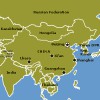Professor Richard Walton (University of Warwick) took part in the 2014 SAFEA-RSC Visiting Researchers Programme, visiting China on the 17-25 September. He spent time at Yangzhou University in Jiangsu province and at the Institute of Physics, Chinese Academy of Sciences, Beijing. Although Richard had been to China a few times previously for conferences, this trip was a chance to visit new places and allowed time for more informal research discussions with various research groups and interaction with some students. In Yangzhou he gave a set of lectures, ranging from research seminars to graduate classes and a paper-writing workshop in addition to visiting the beautiful Slender West Lake and the Bonsai museum. In Beijing he gave a seminar to physicists on some new materials prepared by chemical methods and enjoyed the traditional Beijing hot-pot.
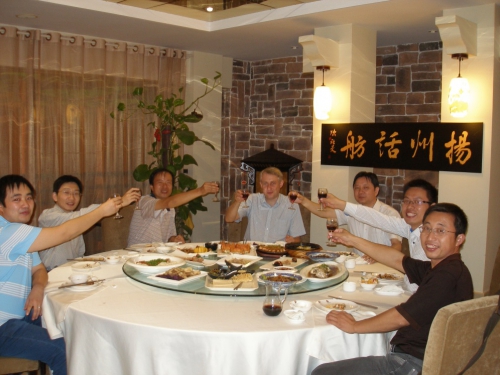
I arrived at Shanghai Pudong Airport at around 11:30 am to be met by my host from Yangzhou, Professor Lou-Lin Zhang. We were then driven to Yangzhou, with a quick stop for lunch, which took over 4 hours in total. I was booked into my hotel, the Hong Qiao Hotel, on the old campus of Yangzhou University where I was to stay during my visit. There was only a short time for a rest before a welcome dinner hosted by Professor Xue Huai Guo, Dean of the College of Chemistry and Chemical Engineering, and I had chance to meet some of the chemistry academic staff, some of whom had had previous interactions with the UK.
Day 2 – Thursday 18th September
After the long journey and the welcome dinner I slept very well, and found I had soon adjusted to the time difference. My host Professor Zhang met me for breakfast at 7:30 and then I had a free morning to spend some time preparing for the lectures I was to give in the days ahead. After lunch I was taken to visit three other campuses of Yangzhou University, in various parts of the city, including the new east campus and the older campus of the agricultural college. The city of Yangzhou has just one university but it is an amalgamation of several older colleges and institutes. In the evening I had a walking tour of the new city centre. Despite raining solidly all day I managed to see several different sides to Yangzhou city.
Day 3 – Friday 19th September
After another early start I spent some time in the College of Chemistry and Chemical Engineering to see the research laboratories and discuss collaborative work with Professor Zhang. In the afternoon I gave two research lectures, back-to-back, which were very well attended by academic staff and over 100 graduate students, and produced lots of questions and discussion: the session lasted for three hours in total, so I welcomed a rest that evening.
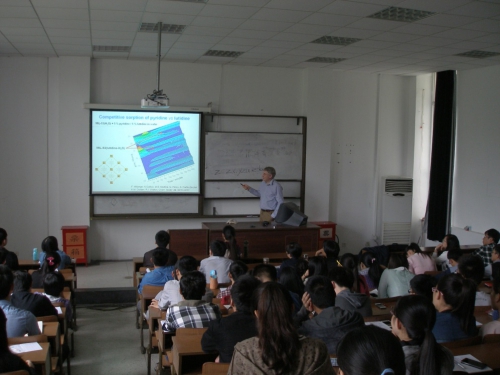 Day 4 – Saturday 20th September
Day 4 – Saturday 20th September
This morning I gave some lectures to graduate students: one based on some of the lectures I give to the students at the University of Warwick on the synthesis and applications of porous materials, and one discussion class on ‘how to write a research paper’. This was another 3 hour session, and after lunch I spent some time discussing research ideas with some academics in the College of Chemistry, before I was taken to the newly developed eastern side of the city for some shopping for the remainder of the afternoon.
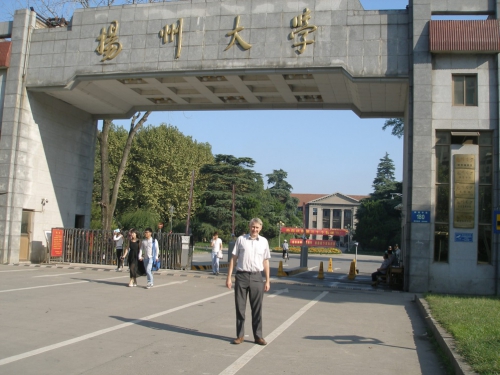
Day 5 – Sunday 21st September
This was an intensive day of sightseeing. I was first taken to the famous Slender West Lake, one of the famous landmarks of Yangzhou, and in fact just adjacent to the campus on which I was based. Since the weather was fine, myself and Professor Zhang walked from the south to the north gate, which took around 3 hours in total. The lake was clearly deserving of its status as one of the major tourist attractions of Jiangsu province and around the extensive grounds were many places of interested including temples and an impressive penjing (bonsai) museum. After a lunch with Professor Zhang’s wife and son, which included many of Yangzhou’s famous dishes, we visited Daming temple. This is one of the largest Buddhist temples in this part of China, and clearly was another major tourist attraction.
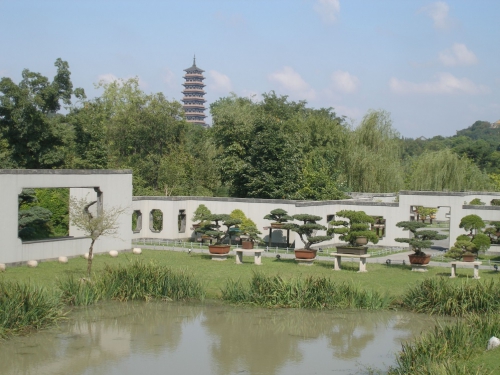 Day 6 – Monday 22nd September
Day 6 – Monday 22nd September
The morning was spent visiting Geyuan (bamboo) gardens, an extensive set of gardens with different rock sculptures representing each of the four seasons, and living quarters originally the home of a wealthy merchant in the 19
th century. The afternoon I had free for further discussions with various members of the academic staff and some students who were interested in apply for postgraduate study in the UK. Finally a farewell meal was arranged in a restaurant on the campus with another group of chemistry academics.
Day 7 – Tuesday 23th September
Flight to Beijing in the morning from the new Yangtai Airport , about one hour from the city centre, arriving lunchtime in Beijing to be met by Professor Huaixin Yang. The afternoon was spent with a tour of the new Institute of Physics building (Chinese Academy of Sciences): this is a huge building, 10 stories high, and is an addition to the original campus, just across the road. With my expertise in materials characterisation I particularly interested to see the excellent new electron microscopy facilities, including some new equipment under development.
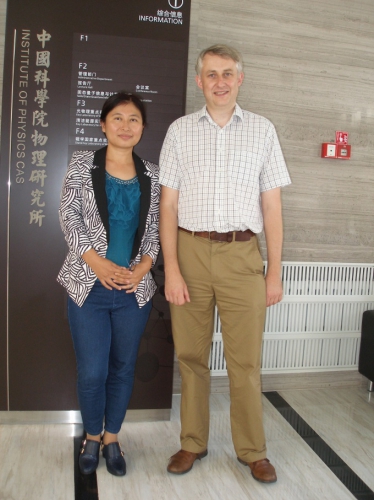 Day 8 – Wednesday 24th September
Day 8 – Wednesday 24th September
The morning provided time for discussion of some possible research projects on oxide materials, combining my interests in materials synthesis with the high-level characterisation available in the Institute of Physics. Then after lunch I gave a seminar on some new materials prepared by my group that have interesting physical properties. Although my seminar was in competition with a nanoscience conference being hosted by the Institute of Physics, I had a very good audience, who asked plenty of questions and this lead to some useful contacts being made for future research collaborations. In the evening Professor Jianqi Li, head of one of the electron microscopy research groups, hosted a farewell dinner, traditional Beijing hot-pot.
Day 9 – Thursday 25th September
I departed Beijing late morning for my flight back to London. The trip went smoothly and I was at home by 10 pm UK time, ready to start preparing the next day for the start of our own academic year the following Monday.
I am extremely grateful to the RSC and SAFEA for providing me the opportunity to make this trip to China, and to my hosts for their endless hospitality. The advantage of an exchange visit like this is the amount of time available for informal discussions around the official business of giving lectures and classes, in which the foundation for longer term collaboration can be made. It was especially pleasing to have had the opportunity to engage with students who were highly enthusiastic about studying chemistry and made such an effort to communicate and interact.
